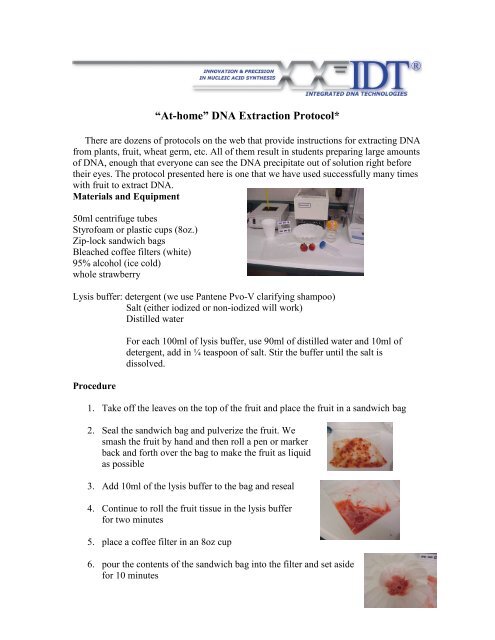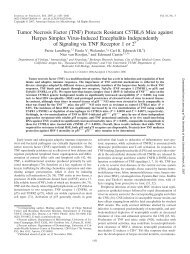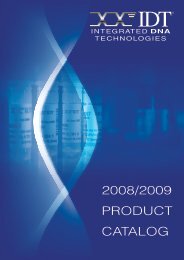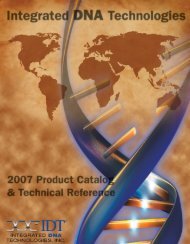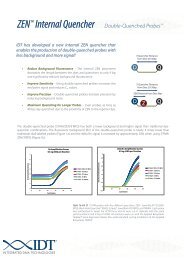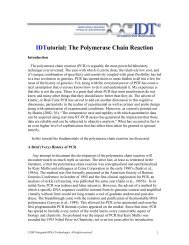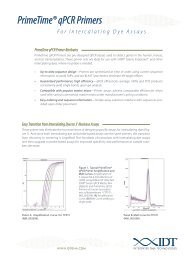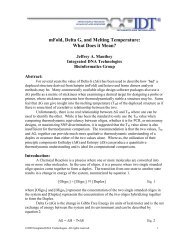âAt-homeâ DNA Extraction Protocol*
âAt-homeâ DNA Extraction Protocol*
âAt-homeâ DNA Extraction Protocol*
Create successful ePaper yourself
Turn your PDF publications into a flip-book with our unique Google optimized e-Paper software.
“At-home” <strong>DNA</strong> <strong>Extraction</strong> <strong>Protocol*</strong><br />
There are dozens of protocols on the web that provide instructions for extracting <strong>DNA</strong><br />
from plants, fruit, wheat germ, etc. All of them result in students preparing large amounts<br />
of <strong>DNA</strong>, enough that everyone can see the <strong>DNA</strong> precipitate out of solution right before<br />
their eyes. The protocol presented here is one that we have used successfully many times<br />
with fruit to extract <strong>DNA</strong>.<br />
Materials and Equipment<br />
50ml centrifuge tubes<br />
Styrofoam or plastic cups (8oz.)<br />
Zip-lock sandwich bags<br />
Bleached coffee filters (white)<br />
95% alcohol (ice cold)<br />
whole strawberry<br />
Lysis buffer: detergent (we use Pantene Pvo-V clarifying shampoo)<br />
Salt (either iodized or non-iodized will work)<br />
Distilled water<br />
Procedure<br />
For each 100ml of lysis buffer, use 90ml of distilled water and 10ml of<br />
detergent, add in ¼ teaspoon of salt. Stir the buffer until the salt is<br />
dissolved.<br />
1. Take off the leaves on the top of the fruit and place the fruit in a sandwich bag<br />
2. Seal the sandwich bag and pulverize the fruit. We<br />
smash the fruit by hand and then roll a pen or marker<br />
back and forth over the bag to make the fruit as liquid<br />
as possible<br />
3. Add 10ml of the lysis buffer to the bag and reseal<br />
4. Continue to roll the fruit tissue in the lysis buffer<br />
for two minutes<br />
5. place a coffee filter in an 8oz cup<br />
6. pour the contents of the sandwich bag into the filter and set aside<br />
for 10 minutes
7. discard the coffee filter and its contents<br />
8. pour 30ml of ice cold 95% alcohol into a 50ml centrifuge tube<br />
9. pour the contents of the 8oz cup into the tube, cap the tube, wait for the <strong>DNA</strong> to<br />
start precipitating out in the alcohol (the process begins almost immediately and<br />
the <strong>DNA</strong> will continue to condense for the next few minutes)<br />
<strong>DNA</strong> starting to<br />
precipitate in the<br />
alcohol<br />
5 min.<br />
Condensed<br />
<strong>DNA</strong><br />
Other, very good, protocols can be found at the web sites provided below. Many of these<br />
protocols are more involved than the one shown here but they do cover a wide range of<br />
possible samples including onion, wheatgerm, lima beans, kiwi, yeast. We have also used<br />
our protocol with tomatos. We like the strawberry because it is very simple and it smells<br />
really good.<br />
www.biotech.iastate.edu/publications/lab_protocols/<strong>DNA</strong>_<strong>Extraction</strong>_Kiwi.html<br />
www.exploratorium.edu/ti/human_body/dna.html<br />
http://biotech.biology.arizona.edu/labs/<strong>DNA</strong>_extraction_onion_studt.html<br />
http://gslc.genetics.utah.edu/units/activities/wheatgerm/<br />
www.accessexcellence.org/AE/AEC/CC/<strong>DNA</strong>_extractions.html<br />
*This protocol was given to us by Julie Townsend, Parkview Middle School, Ankeny,<br />
Iowa.


